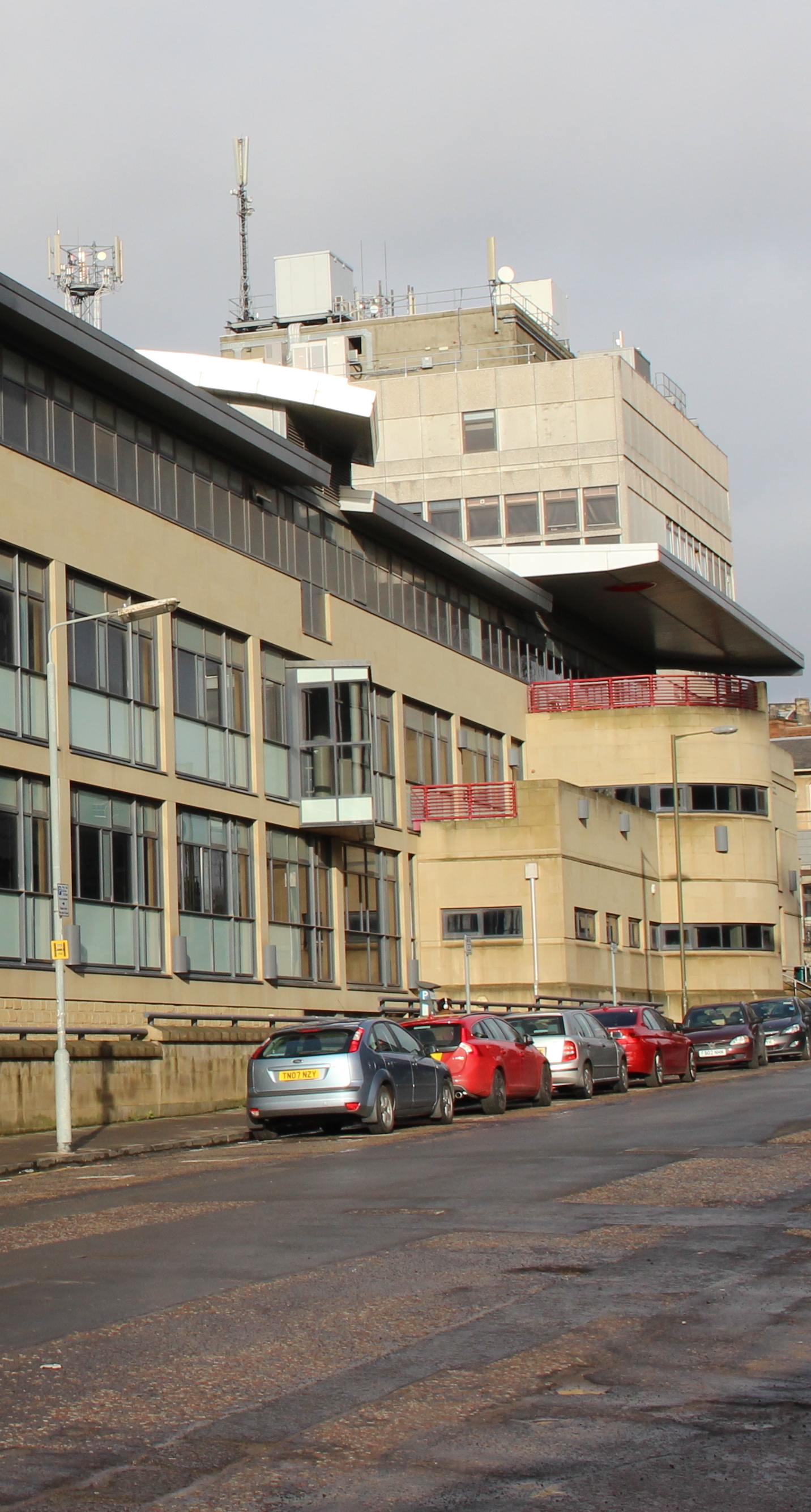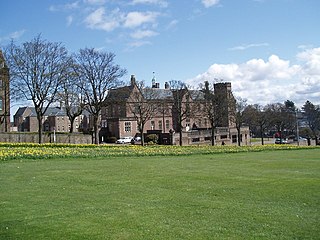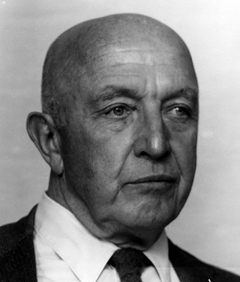
Sir William Macewen, was a Scottish surgeon. He was a pioneer in modern brain surgery, considered the father of neurosurgery and contributed to the development of bone graft surgery, the surgical treatment of hernia and of pneumonectomy.
Dame Agnes Gwendoline Hunt DBE RRC was a British nurse, who is generally recognised as the first orthopaedic nurse.

The Western General Hospital is a health facility at Craigleith, Edinburgh, Scotland. It is managed by NHS Lothian.

The Royal Infirmary of Edinburgh (RIE), often known as the Edinburgh Royal Infirmary (ERI), was established in 1729 and is the oldest voluntary hospital in Scotland. The new buildings of 1879 were claimed to be the largest voluntary hospital in the United Kingdom, and later on, the Empire. The hospital moved to a new 900 bed site in 2003 in Little France. It is the site of clinical medicine teaching as well as a teaching hospital for the University of Edinburgh Medical School. In 1960, the first successful kidney transplant performed in the UK was at this hospital. In 1964, the world's first coronary care unit was established at the hospital. It is the only site for liver, pancreas and pancreatic islet cell transplantation and one of two sites for kidney transplantation in Scotland. In 2012, the Emergency Department had 113,000 patient attendances, the highest number in Scotland. It is managed by NHS Lothian.

Fairmilehead is a district of southern Edinburgh, Scotland. It lies approximately 3 miles (5 km) due south of the city centre and borders Midlothian. The area comprises the neighbourhoods of Buckstone, Caiyside, Caiystane, Swanston, Frogston and Winton.

The Edinburgh Royal Maternity and Simpson Memorial Pavilion was a maternity hospital in Lauriston, Edinburgh, Scotland. Its services have now been incorporated into the Royal Infirmary of Edinburgh at Little France.
Sir John Charnley, was an English orthopaedic surgeon. He pioneered the hip replacement operation, which is now one of the most common operations both in the UK and elsewhere in the world, and created the "Wrightington centre for hip surgery". He also demonstrated the fundamental importance of bony compression in operations to arthrodese (fuse) joints, in particular the knee, ankle and shoulder.

NHS Lothian is one of the 14 regions of NHS Scotland. It provides healthcare services in the City of Edinburgh, East Lothian, Midlothian and West Lothian areas. Its headquarters are at Waverley Gate, Edinburgh
Bangour General Hospital was a hospital just west of the village of Dechmont, West Lothian, Scotland. It had its origins during the Second World War when hospital bed numbers in Scotland were greatly expanded to deal with the anticipated increase in civilian and military war casualties. The Emergency Hospital Service (Scotland) scheme resulted in seven new hospitals being built, while at Bangour Village Hospital in West Lothian an annexe of five ward blocks was built and this developed into Bangour General Hospital after the war. This hospital served the population of West Lothian as a general hospital and also included a maxillo-facial unit serving the Lothian region and a burns and plastic surgery unit serving much of east Scotland, the Borders and the Highland region. The hospital services were transferred to the newly built St John's Hospital at Livingston during 1989–90, and Bangour General Hospital closed in 1990 and was subsequently demolished.

The Leith Community Treatment Centre is a community hospital in Junction Place, Leith, Edinburgh, Scotland. It is managed by NHS Lothian.

The Princess Alexandra Eye Pavilion is a specialist eye treatment centre in Edinburgh, Scotland. It is managed by NHS Lothian. It provides ophthalmic care for Edinburgh and the Lothians, and tertiary care for South East Scotland.

The Lauriston Building is an out-patient centre in Edinburgh, Scotland. It is managed by NHS Lothian.

Edinburgh BioQuarter is one of the UK’s leading health innovation locations. It boasts an established and growing ecosystem where leaders in healthcare, academia, economic development and local government work together to deliver a shared vision for its development.

Dundee Royal Infirmary, often shortened to DRI, was a major teaching hospital in Dundee, Scotland. Until the opening of Ninewells Hospital in 1974, Dundee Royal Infirmary was Dundee's main hospital. It was closed in 1998, after 200 years of operation.
John Chalmers is a Scottish orthopaedic surgeon.

Sir Harold Jalland Stiles was an English surgeon who was known for his research into cancer and tuberculosis and for treatment of nerve injuries.

Sir Walter Mercer KBE FRSE FRCSEd FRCPE LLD was a Scottish orthopaedic surgeon. He was President of the Royal College of Surgeons of Edinburgh from 1951 to 1956. He was affectionately known as 'Wattie.' His collection of anatomical specimens was donated to Surgeon's Hall in Edinburgh, and is now known as the Walter Mercer Collection.

John Ivor Pulsford James was a British orthopaedic surgeon. He was professor of orthopaedic surgery at the University of Edinburgh from 1958 to 1979. Most commonly known as "JIP", he was secretary then president of the British Orthopaedic Association which later awarded him its honorary fellowship. James attracted orthopaedic specialists to work in Edinburgh, encouraging them to develop an interest in a specialist area of orthopaedics, and in this way he was able to establish a comprehensive regional orthopaedic service. He made contributions to hand surgery and surgical treatment of scoliosis, and was a prime mover in promoting specialist training and qualification in orthopaedic surgery in the UK.

Ian Scott Smillie OBE, FRCSEd was a British professor of orthopaedic surgery who became an international authority on conditions of the knee. He devised techniques and instruments to facilitate the surgical excision of the damaged knee meniscus. He was an early advocate of specialist team care in orthopaedics and of early mobilisation. His textbooks Injuries of the knee joint and Diseases of the knee Joint were widely read throughout the world. In 1981 he was elected president of the International Society of the Knee.

The Edinburgh City Hospital was a hospital in Colinton, Edinburgh, opened in 1903 for the treatment of infectious diseases. As the pattern of infectious disease changed, the need for in-patients facilities to treat them diminished. While still remaining the regional centre for infectious disease, in the latter half of the 20th century the hospital facilities diversified with specialist units established for respiratory disease, ear, nose and throat surgery, maxillo-facial surgery, care of the elderly and latterly HIV/AIDS. The hospital closed in 1999 and was redeveloped as residential housing, known as Greenbank Village.


















